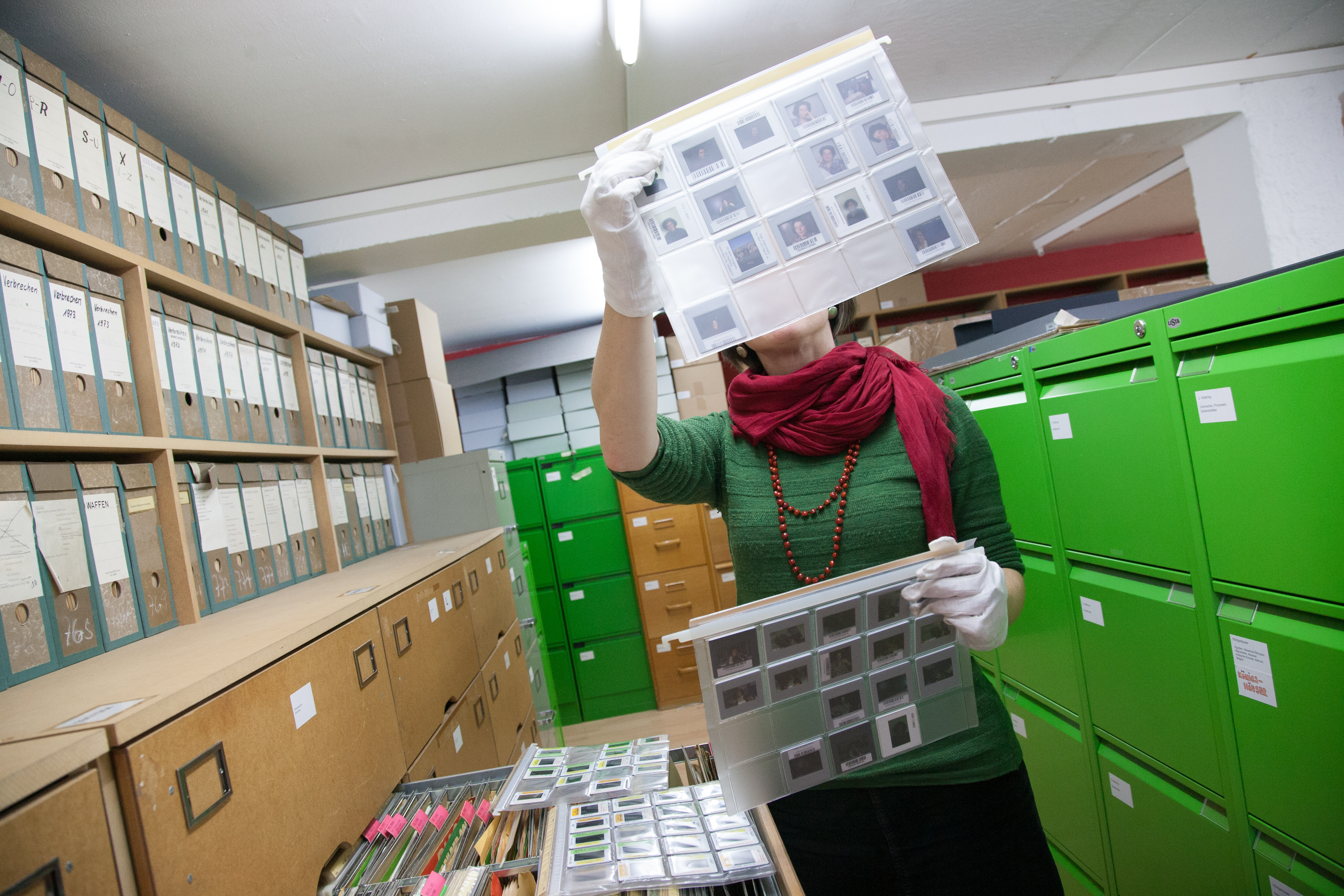The struggle to save images in the digital age

Conserving Switzerland’s rich photographic heritage well into the future is going to be tricky. It’s not so much the technical challenge of archiving collections twice – digital and analogue – but the political and financial problems it also brings.
A box of glass plates sits next to the scanner: “These are photos taken by my grandfather, a minister in Grindelwald, nearly 100 years ago,” says Christoph Balsiger, a photo editor at swissinfo.ch.
“There are portraits, flowers, the countryside, mountains… in this one, I recognise the Eiger mountain, but the rest… no idea: there is almost never any indication,” says Balsiger as he carefully replaces one plate and brings out another. A treasure trove? Nothing could be less certain.
The value of amateur photography is “just about zero because they are almost always of the same things: portraits or unidentified countryside”, says Martin Gasser, conservationist with the Swiss Photography Foundation in Winterthur. Many Swiss had the means to buy a camera at the turn of the last century, helping it to become a mass industrial product and a universal language.
Add to this, photographs taken in a professional capacity, notably by the press. Although the number of titles has diminished in recent years, Switzerland still counts a record number of publications. Between 1930 and the 1990s, Switzerland’s biggest media company, the Ringier Group alone accumulated some seven million photo archives.
This immense visual heritage is held in libraries, museums and … family attics. The longevity of amateur photography is not guaranteed, and neither is that of the professionals.

More
Inside Switzerland’s prized press archive
Save or discard it
“Private citizens often offer us their archives. In general, we refuse them but we give them advice on how to choose what they should keep, what to throw out or … what to sell at the flea markets,” says Gasser. “We keep the interesting subjects, for example the rare and specialist photographs taken by an engineer during the First World War, but rarely the entirety of a collection.”
Gasser adds that even with professional photographs “hard choices” need to be made.
“Our mission is to conserve the analogue material of the 19th century, to the end of the 20th century. We try to keep the most important subjects and photographers, but also what is significant on a national level, all regions included.”
The Foundation has one million plates, negatives, slides and prints which it keeps in air-conditioned storage to slow the damage caused by time and chemical products. Gasser points out that “the Federal Culture Office has considerably reinforced its support over the last ten years but it is a drop in the ocean” of what is needed.
Since the establishment of the Law to Encourage Culture on January 1, 2012, the Federal Culture Office has supported the Swiss Photography Foundation in Winterthur to the tune of CHF1.25 million annually for photographic archiving.
The culture office has also committed to “remembrance policy”, which covers Swiss audio-visual heritage as a whole: photos, sound recordings, film and video. This translates into financial support for the Memoriav foundation created in 1995 by the National Library, Federal Archives, National Sound Archives, Swiss Film Association, Swiss Broadcasting Corporation, the Federal Communications Office and, since 1998, the Swiss Institute for Photographic Conservation.
Memoriav has referenced some 80,000 audio-visual documents from 13 organisations on its site www.memobase.ch.
Memoriav has an annual budget of CHF3.5 million, of which CHF3.1 million is provided by the state, with the rest coming from the SBC and member fees. Of the total, CHF600,000 is dedicated to photography.
Photographic archives are also managed by the federal and cantonal libraries, archives and museums.
(Source: Federal Culture Office and Memoriav)
Digital, “another job”
Also, the job of transferring some of the analogue material to digital platforms requires a stricter selection process, but Gasser says this is not a priority.
“First we have to conserve these items, 90 per cent of which no longer hold a large interest today. And tomorrow? The difficulty is knowing what to keep,” he says.
So the problem comes back to one of money because the cost of archiving is double: scanning the material onto digital servers does not mean you don’t need to keep the original.
With digital archiving, the question becomes one of technology. For reasons of security, the work of scanning the material occurs in tandem on two supports. But due to the constant development of new standards and systems, the data must be regularly migrated (about every five years) on to new servers.
Viewing this as “another job”, the Swiss Photography Foundation has confided the management of its digital catalogues to the Swiss Federal Institute of Technology Zurich (ETHZ), which has integrated them into its E-Pics portal.
“The technology problems can be resolved but the photos need to be specifically accompanied by metadata to be classified and then found again,” explains Nicole Graf, head of photographic archives at the ETHZ.
Housed within the humanities research institute at the University of Basel, the Digital Humanities Lab undertakes the long-term archiving of documents, photos, multimedia and scientific works.
Notably, the organisation is developing a process for the mass, automatic copying of data, with a view to creating an unlimited and perpetual archive.
“The technology, the hard drives, that costs nothing. What is expensive is the digitisation, which must be well done,” explains Lukas Rosenthaler, who heads up the project sponsored by the Swiss Academy of Sciences. “We are working on an automatic and constant migration.”
The system is still at an experimental level and the researcher is hoping “it will be operation within five years”. Ideally, that would bring down the price of terabyte (500,000 photos), currently around CHF500 – CHF3,000 ($568 – $3,411) per year, all inclusive (process, security etc.), to between CHF50 and CHF250 for the automatic version. “But these are just estimates,” says Rosenthaler.
Scattered strategies
On a national level, what do we do with these thousands of files and collections?
Christophe Brandt, director of the Institute of Photographic Restoration at Neuchâtel, laments the lack of a veritable analogue archive system.
He notes that the big challenge of the coming years will be to guarantee ways of watching films without the need for major technological means.
Therefore the work of scanning negatives for archiving must continue.
“Like everyone, Switzerland will move towards long-life servers,” says Brandt, who is also a member of Memoriav, a national network dedicated to safeguarding the country’s audio-visual heritage.
“But everyone is doing it as best they can: the ETHZ, Federal Archives, Memoriav, the Photographic Foundation, the Elysée Museum, our organisation. There is not a centralised system, but a few independent providers. Everyone is conscious that the strategies are scattered, but would everyone accept a single base? And which one to choose?” says Brandt.
Edzard Schade, a specialist in multimedia archiving who teaches at the Institute of Applied Sciences in Chur, suggests the problem is less technical than political.
“The country needs to take more responsibility and encourage a real national policy. There would be enough sources of financing; after all we give enough money, also private, to the information society. But we should do it quickly, because the problem is getting worse,” he says.
(Translated from French by Sophie Douez)

In compliance with the JTI standards
More: SWI swissinfo.ch certified by the Journalism Trust Initiative
You can find an overview of ongoing debates with our journalists here . Please join us!
If you want to start a conversation about a topic raised in this article or want to report factual errors, email us at english@swissinfo.ch.